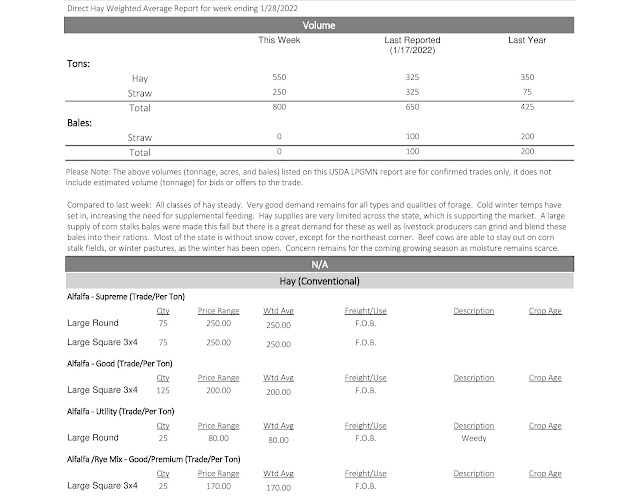Friday, January 28, 2022
Thursday, January 27, 2022
Wednesday, January 26, 2022
State-By-State Hay Summary
Colorado—In the Jan. 13 report, compared to last week, trade activity light on good demand for horse hay markets. Trade inactive on dairy and feedlot markets. All markets sold steady this period. According to the U.S. Drought Monitor’s High Plains Summary for Jan. 11, substantial precipitation (over 0.5 inch) was generally restricted to higher-elevation areas in Wyoming and Colorado. Heavy precipitation has been common across the higher elevations of central and northern Colorado in the past couple of months. Some of these mountains received several inches more than normal precipitation in the last 90 days, resulting in abundant snowpack that prompted drought improvement through this region.
Missouri—In the Jan. 13 report, compared to last report, given that many farmers have ample supplies hay business remains somewhat slow with most interest continuing to be from equine or small animal interest. The supply of hay is moderate and demand is light to moderate and prices mostly steady. A decently mild week around the state between winter storms and cold temperatures. Hay production and stock numbers were released in USDA reports this past week officially showing just how grim the growing season was in many states. Nationwide December hay stocks were reported at a 10 year low, with the Dakota’s reporting over a 40% decline in stocks. As many know Missouri was very lucky, although production was down from 2020 hay stocks in Missouri were reported as the second highest in the nation, behind only Texas.
Nebraska—In the Jan. 13 report, compared to last week, comparable trades of baled hay in the Platte Valley and Central Nebraska sold steady to weak. Ground and delivered hay throughout the state remained steady. Demand was moderate with sporadic trade within the state. Most cattle remain on cornstalks and require little supplementation. Trade and inquiries continue from the states west and north of Nebraska. Contacts reported little to no precipitation throughout the state over the past week.
Oklahoma—In the Jan. 7 report, compared to the last report, weather continues to stay warm temperatures; hay is slow to steady. The warm weather conditions allow the cattle to still hang on to the free-standing grass. They are not taking to the hay when compared to more climatically challenging conditions. Hay remains the main feed resource due to prices of feed. We are currently in severe drought in the east and an extreme drought central/west according to the Mesonet. The next report will be released Jan. 21.
Texas—In the Jan. 7 report, compared to the last report, hay prices are steady in all regions. Trading activity and demand were moderate. South Texas received its first frost of the season this week, which has stopped the growth of warm season grasses. Pastures are still in good condition despite the frost, and more rain is in the forecast this week which should offer a boost to cool season grasses. The rest of the state is in desperate need of some moisture. Temperatures have been above average for this time of year and have been accompanied by high winds. This has further dried out soil moisture levels. As of Dec. 28, Amarillo has observed no precipitation for 76 consecutive days which is the second longest dry streak on record, according to the US Drought Monitor. Consequently, hay demand has remained steady as winter feeding is in full swing in all regions. Next report will be released Jan. 21.
New Mexico—The hay growing season is over. Last report for the season was issued Nov. 5, 2021. Reports will resume in April 2022.
South Dakota—In the Jan. 13 report, compared to last week, all classes of hay steady. Good to very good demand for all types and qualities of hay, good demand for straw and corn stalk bales as well. Last week’s arctic like weather was replaced with temps near or above 50 degrees helping to lessen the need for supplemental feed to maintain body condition. Snow forecast for East River at the end of the week as a large system moves south but will miss western South Dakota where snows are needed to fill stock dams. Corn stalk bales remain in high demand, compared to previous years, as cattle producers grind and blend the stalks to cheapen their forage cost.
Wyoming—In the Jan. 13 report, compared to last week, reported hay trades sold steady to weak on a light test. Trade and demand are moderate and sporadic and supply is limited. Snow expected in the next week in eastern regions of the state.
Montana—In the Jan. 14 report, compared to last week, hay was too lightly tested this week to develop an accurate market trend. Demand for hay remains very good. Many producers are starting to run out of hay or are slowing sales in order to have some inventory going into spring. While limited offerings of hay remain available very light sales were seen this week. Warmer weather has returned and is helping to curb feed needs. Temperatures reached the low 50s across much of the southern portions of the state. With warmer weather, winds have been brisk, which has started to dried out the topsoil in many locations. Traders buying hay from surrounding states continue to deliver hay into Montana for $300-$325.
Tuesday, January 25, 2022
Hay Market Demand and Price Report for the Upper Midwest
Demand and Sales Comments
Prices are steady this week for dairy quality hay. Forecasted cold weather may drive sales. If you have questions on this report contact richard.halopka@wisc.edu . If you need forage or have forage to sell or straw, connect to the Farmer-to-Farmer website. You may contact your local county agriculture educator if you need help placing an ad. There is no charge for the service.
Straw prices are for oat, barley, or wheat straw. Straw prices are steady to strong. Small square bales averaged $4.45 a bale (range of $3.00 to $6.00). Large square bale straw averaged $43.00 per bale (a range of $21.00 to $74.00). Large round bale straw averaged $42.00 per bale (range of $35.00 – $70.00).
In Nebraska, hay sold steady with slow movement of hay. Drought is a concern, but has not spurred hay sales. In Iowa, no report.
In South Dakota, all classes of hay had steady to weaker prices. There is a very light test in the market.
In Missouri, hay supply is moderate and demand is light to moderate with prices mostly steady. Small orders are currently the most common.
In Southwest Minnesota, no report. In Kansas, hay market prices remain steady, movement remains slow. There are some drought concerns, but currently it has not had an impact on hay prices or sales.
In Wisconsin, prices are steady too strong for dairy quality hay.





















































